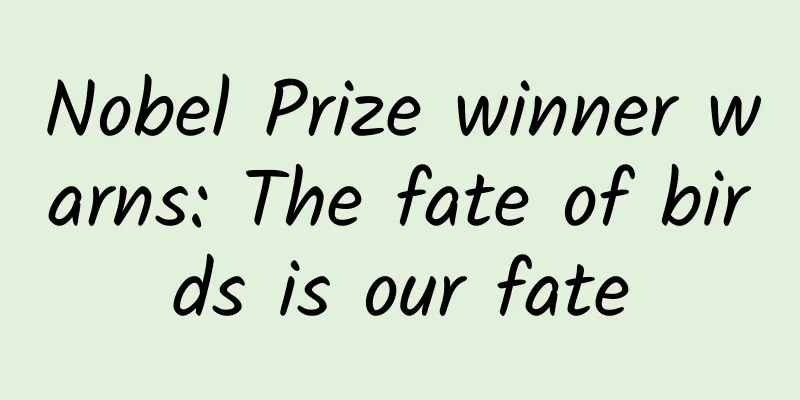Nobel Prize winner warns: The fate of birds is our fate

|
With the sales of this little book, I would like to see the degree of psychological maturity of the Chinese reading community. In recent years, many knowledgeable people have despised pure chicken soup for the soul. However, the so-called "nature writing" that is everywhere in bookstores is also a disguised chicken soup. At best, it is just interesting knowledge about animals and plants. However, interest and knowledge are not the same as wisdom. This book has profound thoughts and a broad perspective. It is not lacking in knowledge and fun, but more importantly, it inspires thinking and self-examination of life. For advanced readers, it may even open up some scientific research methods in addition to pure mental satisfaction. ——Translator This article is authorized to be excerpted from "Humans and Birds Living in Harmony" (Hunan Science and Technology Press, August 2021 edition), and the title is added by the editor. Written by Li Shaoming I just translated a small book, the title of which I translated as "People and Birds Together", which should be literally "Their Fate is Our Fate - How Birds Warn of Threats to Us and Our World", written by Peter Doherty, an Australian microbiologist and immunologist, and Nobel Prize winner. As I translated it, I fell in love with the book. Now that I have nothing to do, I want to talk about this bird book. I like plants, which is related to the fact that I used to be a farmer. Farmers have to grow crops, vegetables, and raise animals. Crops and vegetables are domesticated plants. Raising animals means dealing with all kinds of wild grasses. I think I could identify hundreds of useful and useless grasses since I was very young. Having experienced famine and poverty, identifying edible wild grasses was once a survival skill for my generation. As I grew up, I learned some Chinese medicine and read some painting manuals, which increased my interest in flowers, plants, and trees. My interest and knowledge of birds were far behind. Chickens, ducks and geese must be familiar. Cage birds require "conditions". The family motto I received since childhood included "If you want to be poor, play with caterpillars", which means that children from poor families should not raise birds. When I was a teenager, there were many wild birds in my hometown, and there were often people who hunted birds. In our countryside, hunters were both envied and despised. In the eyes of ordinary people, they were frivolous and vagrants. I had the opportunity to observe those people up close, but I never got into their lives. My bird hunting practice was the lowest among boys: I made a slingshot and shot the "bull-eyed eggs" jumping between willow branches and leaves. The scientific name is willow warblers. Among my companions, there were advanced bird-playing people who kept "wolai" - a kind of lark - and magpies all year round. In the spring, they would also bring "clip" and large nets to harm those migratory birds passing by, mainly turtledoves and "chuanchuan chickens". These are all medium-sized birds for meat. I also caught some nice little birds, which I could raise or sell. My pleasure was limited to watching the geese flying high in the sky in the fall and listening to the loud crane calls in the wheat fields outside the village in the winter. In high school and after high school, I occasionally drew birds according to the painting manual for my own amusement, but I didn't gain any experience. The book "Man and Bird" mentions "The Birdman of America" John James Audubon (1785-1851) in many places. I have a little fate with Audubon. In my humble experience of book hunting, Audubon's medium-sized picture album "The Birds of America" (1840) is also worth remembering. It is a popular version decided by Audubon himself in 1839, with a size of 10½ x 6½ inches and 500 pictures. Today, the market price of this first print in good condition can reach US$25,000. My property is the 1994 edition, with light beige denier high-quality paper, single-sided printing, excellent printing, and dazzling color ink. It is as precious and proud as the six volumes of "Royal Museum" I found in the UK. Left: John James Audubon 1826 portrait; Right: Illustration of "Birds of America": a wild turkey | Source: Wikipedia Knowing Audubon, he also helped me make friends. When I was translating a book that year, I had a question about the Bible. I heard that there was an American foreign teacher in the economics department who was proficient in the Bible, so I rashly knocked on the door of the person's apartment. The host was sitting facing south. On the west wall, I caught a glimpse of a unique round wall clock. After the greetings, I looked up and asked, "Audubon?" The person was delighted and said, "Yes! Do you like Audubon too?" Then I learned that the host was an Audubon fan. Not only the clock was Audubon, but also the teacups and coasters were products of Audubon Company. The wall clock has a special feature: there are no numbers, but instead, there are images of 12 birds. The host said that at every hour, a special bird's call would be heard. So the host and the guest had a great conversation, the problem was solved, and I was given a New International Version of the English Bible, which is still on the bookshelf. I translated Doherty, whose love and knowledge of birds are unmatched. This book talks about the health and diseases of birds, but it is not as annoying as imagined. Although there are inevitably many diseases, viruses, bacteria and parasites, and immune mechanism terms, there are still a lot of space about the stories of birds and bird people. These stories are fascinating and captivating, touching people's love and curiosity, and also include concerns and understandings about ecology, economy and culture. There are several sections that most readers will benefit from reading; to be honest, as far as I am concerned, reading any one of these sections will make me feel that it is worth the money. These sections are: avian physiology (and chicken embryology); traditions and culture associated with birds; The story of bird disease scholars; many scientific superstars started out by studying bird diseases, and quite a few of them were colleagues or peers of the author. As a result, we learned a lot of details about the scientists' experiences, personalities, behaviors, fates, and achievements, and thus learned a lot about "how science is done"; Past scientific research; Doherty also talked about how scientific research was done in the past. Some fine traditions have not lost their meaning and value. Therefore, those large areas of science - microbiology, genetics, immunology, virology, public health, phenology... are no longer rigid facts. They are all specific studies created by real people, with joys and sorrows and stories. As a result, scientists are no longer “living zombies in white coats.” They even wrote poems and danced. We know that the birdman Audubon was a great painter. In fact, we can see that the author of this book, Doherty, is also a great reader. He reads a lot of history and a lot of literature. The writers he mentioned and discussed in depth, from Shakespeare to Keats and Shelley, from Burns, Blake to Coleridge, their contributions to humanity and our understanding of the world, and the contributions of bird researchers to our understanding of the world, complement each other and are indispensable. What is particularly magical is that there is a bird behavior scholar who is also an accomplished professional dancer, and when choreographing and dancing, the scholar-dancer seems to have a deeper understanding of the spiritual world of birds—— So, there is also: the aesthetics of birds. 01 Bird Physiology Birds are good at flying, which makes all of us "bipedal hairless animals" envious. I live on the 6th floor, and I often imagine how I can jump out of the window, even if it is just the simplest glide. I have been practicing push-ups and pull-ups for several years, but my performance has quickly reached the ceiling, so every time I try hard for a few days, I give up. In this respect, the birds are far ahead of us by several trees. We are so far behind them. It starts with their skeletons. As we quickly learned when eating Texas Braised Chicken, chicken bones are more porous than those of pigs and cows, with leg bones literally hollowed out. It has to be this way, of course, to reduce the pull of gravity. More importantly, birds’ skeletons are fundamentally different from those of mammals. To withstand the impact of landing, their lower spines are fused to their enlarged pelvises (which saves them from back pain). Structural rigidity is also necessary to support the powerful movements of muscles, tendons, bones, skin, and feathers during flight. Huge flexor muscles (pectoral muscles) are needed to lift birds off the ground; and large pectoral muscles need ample attachment surfaces, so the clavicles are fused together—to the furcula in chickens—and the sternum extends downward to form a deep, vertical “keel.” Taking off from the ground or the sea is a natural feat that defies gravity. To do this requires a huge amount of energy, which means that the muscle tissue needs to get a lot of oxygen because the body needs to burn glucose to provide energy for the muscle machine. At the same time, the end product carbon dioxide also needs to be discarded in time. Mammals and birds have lungs, which have tubes that branch and become thinner and thinner, and finally become capillaries. The barrier between capillaries and blood vessels is extremely delicate, with extremely thin walls, so that the circulating red blood cells can contact fresh air, expel carbon dioxide, and take in oxygen. However, the pipe system that air is transported through before reaching the final, single-layer cell-based air-blood interface is very different in birds and mammals. Birds have evolved a more complex one-way overflow-channel respiratory system, while mammals, although larger, have simpler lungs, where fresh air inhaled and waste gas exhaled mix together in the lungs until the balloon-shaped alveoli at the terminal level - gas exchange occurs in the alveoli. Bird lungs do not have "terminal structures" like alveoli. Instead, they use a "continuous flow" system composed of tiny tubes that are interconnected. Because birds have to deal with countless times more air than humans, they are proportionally sensitive to airborne toxins. Ancient coal miners would bring canaries into the mines to detect possible gas concentrations. As the saying goes, flying has its difficulties. Especially for those long-distance travelers, how do they migrate thousands of kilometers? Take the red snipe, a medium-sized wader. It has a lifespan of seven to eight years and travels more than 400,000 kilometers in its lifetime. There are only a few stops on each long-distance flight, so they have to carry a considerable weight before setting off and must refuel on the way. Long-distance migratory birds weigh about twice as much as usual before departure, from 90-120 grams to 180-220 grams in the case of the rufa red snipe. When flying, fat provides the main energy storage. Once fat is exhausted, birds begin to burn protein from internal organs such as the liver and kidneys, and even from the smooth muscles of the crop and intestines, and then extract energy from the striated chest muscles used for flight, resulting in a gradual decline in overall strength. Several well-stocked "Sky Road" food stores along the way are obviously indispensable. Upon arrival, the full health of the gastrointestinal tract and digestive system must be quickly restored; otherwise they become more susceptible to invasion by foreign intestinal microorganisms. Of course, this book cannot be without bird diseases, such as malaria. Once, over coffee, the author told a friend a story about avian malaria, and the friend immediately responded: "But birds are covered with feathers, how do mosquitoes bite them?" An interesting paragraph happened: when sleeping, the relatively disease-resistant Japanese white-eye turns its beak and face backwards, buries it in the loose part of its back feathers, fluffs its chest feathers, and squats so that its abdomen touches the perch. This minimizes the exposure of the corners of the mouth, forehead, legs and feet. When susceptible birds sleep, all these parts are exposed, which is a perfect breeding ground for mosquitoes. As with many infectious diseases, when it comes to susceptibility, behavior may not be the whole susceptibility factor, but it is important. Sleeping Bird by Larry Lamsa丨 This is a very good example that can be used to explain the theory of evolution. Survival of the fittest sometimes depends on this little difference. Yet if we look at the hornbill’s big, ostentatious beak with evolution in mind, or advantages in attracting mates, feeding, or defense, we’d be wrong. For the toucan’s beak primarily functions as a radiator. It has a powerful network of superficial blood vessels that help dissipate heat. Birds don’t sweat, but they lose considerable heat through featherless patches on their bare faces, legs, feet, and (in some species) heads. Extending the wings enhances airflow over large areas of skin that are well supplied with blood by small blood vessels. Different bird species have different arrangements of feathers. Arrangement refers to both the relative positions of feathers to each other and to the body (note to those who learn to draw). Complex feather arrangements help retain or insulate heat. The white, reflective tail can be turned toward the sun. But what about dark-colored birds? Anyone who lives in the tropics knows that it's really hot inside a black car! So, don't black cockatoos, for example, have a clear disadvantage when it comes to absorbing heat compared to white cockatoos? However, birds are not all immobile solid lumps. All it takes is a wind speed of just 3 kilometers per hour to reverse the situation. Then, when the ambient temperature is higher, black birds can dissipate heat more easily. Some species also use a "throat inflation" strategy to help dissipate heat, a "fanning" process that involves rapid relaxation and contraction of the hyoid-muscle tissue in the throat to inflate the tongue, pharynx, and larynx to facilitate smooth airflow in the highly vascular oropharyngeal and upper respiratory tract regions. As the saying goes, there is no bird that is not sick. What should we do if a bird is sick? If I have the flu, I can stay in bed and have my mother feed me poached eggs and apply cold compresses from time to time. At most, I will be fine in a week and I won't miss going to the bank to collect my pension. But what about birds, such as swallows? Not to mention the flu, even a minor infection can affect their flight, and not being able to fly means they can't find food. For migrating birds, illness is even more of a problem. For these long-distance travelers, a minor illness could mean the difference between life and death. To love birds, we must understand them and care about them. Do we love birds enough? (This is also like the legendary "homesickness". Romantic people living in the city always say that they like the countryside and farmers, but do you understand the countryside and farmers? Do you know their sufferings and pains?) 02 Alarm bird Since the mythological era, the important duty of birds is to stand guard. In the Egyptian totem system, there are many gods with human bodies and bird heads. Birds are ibises, falcons, hawks or herons, etc. They have stood guard for the Egyptians. In Western tradition, the cockerel is a symbol of vigilance and is widely used in French heraldry design. During the French Revolution in 1789, the cockerel was used as a national symbol; during World War I, the proud and colorful Gallic rooster faced the black German eagle. Sentinel geese are always associated with human stories. Geese have a strong sense of territory. Once they think you have invaded their territory, they will attack you with loud cries. The way to relieve it is to feed them quickly, so that they think their territory is stable, the years are peaceful, and we are their kind. According to the ancient Roman historian Livy, in the temple of the goddess Juno, it was the divine geese that awakened the tired Roman guards and saved them from defeat at the hands of the Gauls who attacked at night. In modern Scotland, whiskey distilleries are sometimes guarded by geese. Once a thief comes to steal their water of life, the geese will cack loudly. The author said this to bring up a realistic topic: sentinel chickens. The author and a scientific friend once had the following conversation: "Weird," the friend said. "I hit a club and it hit an uneven spot. I hit a chicken coop full of chickens! There are chickens on the golf course! What's going on?" "Huh, sentinel chickens," I responded. "They're put there to monitor for the spread of WNV; that's West Nile virus." Doherty's scientific world straddles two disciplines, virology and immunology. If he were a virologist, he would know what those birds were doing. His golf-science friend saw chickens and didn't think of WNV, which shows how deep the specialization gap in science has become. People who do science are increasingly trapped in their own cocoons, and they are completely unaware of what is happening in the fields closest to them. I have had a similar experience myself. In 2002, when SARS broke out, neighbors were afraid to go out, so they were busy planting trees in front of and behind their houses. One day at noon, I came back from get out of class and my neighbor, Lao Yu, was waiting for me by the door. "Lao Li, can you take a look at this tree?" I asked back: What tree did you buy? "People say it's a magnolia." I asked: How did you buy it? He said: "I asked if there was a magnolia?" I said, "No, this is a hibiscus." He said, oh, then plant it in the back (south side of the building). I wondered: Lao Yu, aren't you a biology student? Lao Yu smiled: "Hehe, microorganisms." The chicken was placed there by human researchers to monitor arboviruses. Arboviruses can reproduce only inside living cells and replicate themselves in the tissues of very different animals. Biting insects, especially mosquitoes and ticks, produce these viruses. When they feed on blood, they either become infected themselves or transmit the disease to warm-blooded species, including humans and all vertebrates with hair and feathers. The ability of sentinel chickens is to produce highly targeted antibodies after being infected naturally in the fields or woods. This is the capital of sentinel chickens. Birds have both thymus glands, which can produce T lymphocytes (including killer T cells; Doherty has been studying that for nearly 40 years), and B lymphocytes or plasma cells, which can produce targeted antibodies. When we detect specific antibodies, we know that a specific pathogen is present. It is also because birds also have the ability to produce long-term immune memory that people have been able to develop many preventive vaccines for the prevention of poultry and caged birds in the past century. It is not only caged and domesticated birds that can serve as our sentinels. In a broader sense, birds that can fly freely all over the world, as long as they are alive, will patrol and monitor for us, sampling and investigating the atmosphere and oceans, sampling and investigating the living conditions of plants, forests, grasslands and even insects. Those places are not easy for us to go to, and those conditions are even more difficult for us to understand. Once these conditions change, they will be reflected in the number and health of birds. We cannot but care about their welfare, just as officers cannot but care about the welfare of sentinels when they are deployed. Many people can teach science. Doherty's skill is to teach us history and culture while teaching us science. Don't say that such "rambling" is irrelevant. When we look at history and culture from the perspective of science, we will no longer think that there is no rational element in those legends; on the contrary, the next time we hear or see a tradition or legend, we will probably think about whether there is something reasonable in it. For example, when I read ancient agricultural books, I found that people who raised silkworms and brewed wine had to fast and bathe at certain times, and abstain from this and that. I thought: Oh, these highly ritualized behaviors, when those who performed them were unaware of the reasons, objectively reduced the chance of infection. In addition, staying up late on New Year's Eve and performing solemn sacrifices have virtually reduced the number of fires that may be caused by burning paper money, burning incense and setting off firecrackers. 03 The aesthetics of birds Here, I do not intend to list the courtship performances of male birds and the aesthetic tastes of female birds. That was Darwin's forte, and he described those behaviors vividly in "The Descent of Man and Sexual Selection". What I want to talk about here is the beauty of birds described by Doherty and, as far as he knows, the artistic reflection of the beauty of birds by humans, which is the aesthetics of birds by humans. Among the so-called "nature writers" I have come across, Doherty's writing style is the most unadorned. He truly appreciates the beauty of birds, but his love for birds is deep, and he does not want to pay too much attention to the surface. When he occasionally writes about birds, it is also a simple sketch. But that's what a master does. He grasps the key points and in a few words, the image is vivid on the paper and unforgettable. Not only that, but he also writes deeply and presents multiple dimensions. For example, he wrote about puffins: "With their orange-yellow beaks and stocky bodies, they are truly adorable. Like children, their heads are large in proportion to their bodies. This is probably why Penguin Books uses the cute puffin as its logo for its children's series." This stroke draws book lovers' thoughts to the world of books, where there are the legendary penguins and the equally legendary Penguin Books, the highly recognizable three-color block covers, and of course the legendary publishing story of Allen Lane. As you would expect, Doherty also mentioned another lovely image of Penguin Books in the book, which is the non-fiction, academic "Pelican Series". The only thing missing is the fourth image of Penguin Books, the "Peregrine Series", which is its science classic series. When it comes to aesthetics, we can’t avoid talking about painting. When it comes to bird paintings, we can’t avoid Audubon. However, “three words are always about one’s own business”, even when visiting the exhibition of Audubon’s original bird paintings, Dougherty did not forget his scientific research. I would like to bring this up here so that children who love science can know what it means to be open-minded as a scholar. One year, Doherty was invited to Toronto to attend the 50th anniversary celebration of the establishment of the Gairdner International Medical Research Award. As part of the celebration, he went to Ottawa to visit the paintings of Audubon in the Canadian Parliament and similar work done by John Gould and others in the Himalayas, Australia and Papua New Guinea. He must have seen the difference between certain birds in ancient and modern times from those ancient paintings, and thought that he could do further research in the future. He also thought that the large number of 19th-century bird specimens in natural history museums around the world should be more valuable for research. So, after returning to Toronto, he arranged to meet with Alan Baker, the director and curator of the bird museum at the Royal Ontario Museum during the recess of the anniversary celebration. Alan's ancestral home is New Zealand, the kingdom of birds, and he is also an active researcher and outstanding figure in the field of ornithology. Soon our scientist laureate was in the room housing the bird collection, and his thoughts quickly shifted from admiring Audubon’s prints to research mode: Are some of the collections in good enough condition to allow us to genetically compare 18th- and 19th-century specimens with modern birds and conduct a full-blown “molecular archaeology” study? The answer is yes. Not only do they have beautiful, lifelike specimens on display, but they also have a much larger inventory behind them, well preserved and waiting to be studied. Not only whole birds, but also a vast and carefully catalogued collection of bird "skin" samples preserved with arsenic, in such good condition that their DNA can be obtained (through polymerase chain reaction, PCR) for sequence analysis. Doherty also turned around and said to us: Dear public and private collectors, you may have Indian warrior hats and other accessories at home, including feathers, pythons, etc. You should keep them well and find a biologist nearby to ask how to preserve them. Perhaps they can be used for scientific research. The book does not simply touch upon literature; although the text is short, it still constitutes a profound commentary due to its profound thoughts: Keats seems to have had a special fondness for crickets, mentioning them in his Ode to Autumn and then again in The Cricket and the Grasshopper. Keats was a romantic, living in a balmy European landscape, and certainly could not have imagined that locusts would destroy African crops and wipe out the scarce greenery in harsh environments such as Africa and Australia. Shelley also wrote about this, but about larger flying creatures. He is more famous for his bird poems: Hello, happy elf! Who says you are just a bird? You from heaven or near heaven, Pour your whole heart out. Sway at will, be generous and eloquent, The outlet is the wonderful sound of art. “None of us would consider ‘To a Skylark’ to be an accurate biological description of Alauda arvensis, but perhaps the fact that these words are so satisfying reflects the fact that humans have been able to see the natural world in terms of beauty and spirit for much longer than they have been able to see systematically through binoculars. Even now, we prefer Shelley’s skylark to a bird with a lot of gut bacteria.” The best scientists are beyond science. Their understanding and grasp of humanity is often much deeper than that of pure literati. It is precisely because of the existence of such scientists that humans will not fall into another quagmire from which they cannot extricate themselves in their efforts to control nature - the quagmire of scientism. 04 Hardcore science, and the not-so-hard ones The main theme of this book is "going beyond the usual social and environmental themes to explore a darker area - pathology, poisons and plagues", focusing on the relationship between bird diseases and human diseases, and the importance of citizens' participation in bird scientific research. Different people have different perspectives on science. The first is "the public and private sides of science: the public sees the practical utility of science, while researchers focus on the cognition of science". Studying diseases can certainly cure people or save animals and protect people's livelihood. But on the other hand, good science is driven by pure curiosity. The excitement and excitement of discovering something and finding out why is the most important. The author mentioned the principle of "climbing Mount Everest": the reason for climbing is because it is there and it is possible. Good science is not about quick success and instant benefits. Many of the author's cases illustrate this point. For example, the study of a small chicken tumor virus, which seems to have little to do with humans at first glance, later produced rich results in many aspects, including major practical results. As a successful scientist, he also pointed out that "great science involves creativity, insight and broad vision, as well as measurement and rationality." This comment is particularly important for people who aspire to become first-class scientists. Of course, it also helps us ordinary people better understand science. There are many such discussions in this book, so we will not waste more words here. In addition, the author has repeatedly said why the study of wildlife cannot be separated from the participation of the public, why it cannot be limited to a purely human-centered worldview, and what we will lose if that happens; I would like to mention it here to encourage my readers. The profoundness of this book, and of course the author Doherty, lies in his sense of history. Good scholarship cannot be separated from the history of this scholarship; some people even say that all scholarship is history. Only caring about facts and not asking about the origins is the "Grayhardism" that Dickens criticized for harming people's hearts and turning people into "active zombies." During the Cultural Revolution, most of the introductions to scientists and inventors were deleted from our textbooks of mathematics, physics, and chemistry. That was the proper meaning of the inhumane "education." Attaching importance to history is not only to add warmth to academics. It is also fair and just to the pioneers; only by remembering them, their achievements, their humanity and hardships, can future generations say that they are worthy of them. Going further: Like in other fields, fate and history are not always fair to the group of scientists. (It is never fair to experimental animals!) The phenomenon of "one general's success is the death of thousands of people" also exists. Due to chance, due to the times, due to the "accidental" birth, aging, illness and death of scientists themselves and external injustice, due to personality, such as the "strength" of some people and the "indifference" or "generosity" of others, and even due to deliberate slander and suppression, many outstanding characters who should have been recorded in history have fallen into oblivion, which makes those who come after them feel chilled! They also deserve our gratitude and remembrance! Niebuhr, the author of "The History of Rome", once said: "To dig up the past and find the hidden is to create something new." In this regard, Doherty has done a lot. A rough count shows that he describes the life and career of no less than 15 Nobel Prize winners in this book, including many of his colleagues and friends. The book tells many interesting, significant but little-known bird research stories. Each story is written in a way that "sees the object and the person". In addition to the Nobel Prize winners, there are many less famous but equally important and interesting people. Knowing them and remembering them is our responsibility as blessed people. One more thing to add: This book covers many fields. Although the author is a generalist, he was originally a stranger in most of the fields covered in the book. However, when he explored these fields, he received personal guidance and help from top experts in the industry. This ensures the reliability and depth of the book. Last sentence: I did not write this article completely according to the content of the book. Take a look at the table of contents of the book, it is really very interesting. Special Tips 1. Go to the "Featured Column" at the bottom of the menu of the "Fanpu" WeChat public account to read a series of popular science articles on different topics. 2. Fanpu provides a function to search articles by month. Follow the official account and reply with the four-digit year + month, such as "1903", to get the article index for March 2019, and so on. Copyright statement: Personal forwarding is welcome. Any form of media or organization is not allowed to reprint or excerpt without authorization. For reprint authorization, please contact the backstage of the "Fanpu" WeChat public account. |
<<: When I cut the fish, the flesh was blue. I asked: Can I still eat it? Is it delicious?
>>: Thumbs up! my country has overcome this problem
Recommend
Does smoking affect your appearance? It’s true!
Author: Xiao Dan, Director of the Department of T...
21 problems faced by operators, are you affected?
Some time ago, I had in-depth communication and u...
[Collection] A complete collection of essential tools for ASO optimization, some ASO optimization and analysis tools worth recommending!
1. ASO 100: http://aso100.com/ Competitive ASO co...
Father’s Day copy is here, it’s from the heart, not the body! !
Father's Day is coming. They are good at many...
Hot money king Zhang "King of short-term crash course"
Introduction to the resources of "Zhang Tian...
A new breakthrough in transparent materials! The "black technology" of supramolecular glass
Produced by: Science Popularization China Author:...
Samsung launches 31.5-inch 4K UHD monitor to enter the computer field
[September 9th news] At this year's IFA Berlin...
6 key points for overseas marketing promotion!
1. Develop a strategy Before we officially start ...
[Chasing Dreams with Stars] Min Enze: Turning stones into gold, a catalyst for life that never fades
Min Enze is the founder of my country's oil r...
Hubei has zero new cases for the first time! No new local confirmed cases in 31 provinces, autonomous regions and municipalities
[#Hubei's first zero new cases#!#No new local...
It's your car, but not entirely. What are the methods used by manufacturers to remotely lock it? This article will help you avoid pitfalls
The car you buy is not your car, or in other word...
Is the agency fee for Yichang Fitness Mini Program high? Yichang Fitness Mini Program Agency Fees and Process
How much does it cost to be an agent for a fitnes...
In Chinese waters, dugongs are functionally extinct...
This Wednesday, the British journal Royal Society...
Analysis of practical cases of advertising in the education and training industry
What should I do if I want to increase the number...
60 yuan per piece, exported to Dubai! Some people can show off a bowl of it by dipping it in soy sauce...
Entering June, it is the season for eating bayber...









